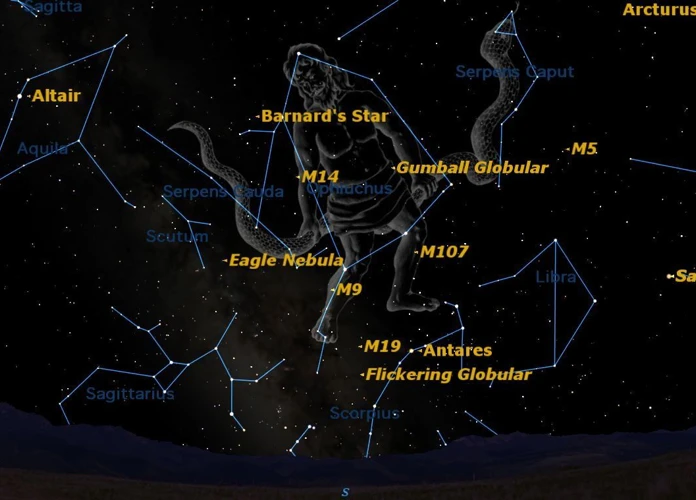Have you ever wondered about the hidden wonders of the night sky? While many of us are familiar with popular constellations like Orion and the Big Dipper, there are lesser-known constellations that are waiting to be discovered. One such constellation is Ophiuchus, which holds a rich mythology and fascinating stars within its boundaries. But alongside Ophiuchus, there are even more constellations that often go unnoticed. In this article, we will delve into the intriguing world of these lesser-known constellations and uncover their hidden secrets. So fasten your seatbelts and prepare for a celestial journey like no other!
Contents
- The Ophiuchus Constellation
- Discovering the Lesser-Known Constellations
- Exploring Serpens
- Unlocking the Secrets of Ara
- Unveiling the Wonders of Scutum
- Untangling the Lupus Constellation
- Journeying through Corona Australis
- Celestial Connections
- Conclusion
-
Frequently Asked Questions
- 1. What is the significance of the Ophiuchus constellation?
- 2. How can I locate the Ophiuchus constellation in the night sky?
- 3. What are some notable stars in the Ophiuchus constellation?
- 4. Are there any myths or legends associated with Ophiuchus?
- 5. Are there any famous celestial objects located within the Ophiuchus constellation?
- 6. How does Ophiuchus relate to astrology?
- 7. Can I see the Ophiuchus constellation with the naked eye?
- 8. What astronomical phenomena have been observed near Ophiuchus?
- 9. Are there any notable historical references to the Ophiuchus constellation?
- 10. How can I learn more about other constellations alongside Ophiuchus?
- References
-
Frequently Asked Questions
- 1. What is the significance of Ophiuchus in astrology?
- 2. How does Ophiuchus differ from other constellations?
- 3. Are the lesser-known constellations overlooked in astronomy?
- 4. What are some interesting facts about the Serpens constellation?
- 5. What is the mythological connection behind the Ara constellation?
- 6. How does the Scutum constellation hold historical significance?
- 7. What is the cultural significance of the Lupus constellation?
- 8. What are the notable features of Corona Australis?
- 9. How do the constellations interact with each other?
- 10. Why are the lesser-known constellations worth exploring?
- References
- Read More
The Ophiuchus Constellation

Ophiuchus, also known as the Serpent Bearer, is a constellation located near the celestial equator. This constellation is unique in that it is depicted as a man holding a snake, representing Asclepius, the Greek god of medicine and healing. According to mythology, Asclepius was known for his ability to revive the dead, which angered Hades, the god of the underworld. As a result, Zeus placed Asclepius in the stars as a constellation to honor his medical skills. Ophiuchus is situated between the constellations Scorpius and Sagittarius, and it is characterized by several bright stars, including Rasalhague and Sabik. With its fascinating mythology and prominent stars, the Ophiuchus constellation offers a captivating glimpse into the wonders of the night sky. For those interested in astrology, Ophiuchus has also gained attention in recent years as a potential thirteenth zodiac sign, offering an alternative perspective on astrological readings and horoscopes. However, it is important to note that this interpretation of Ophiuchus is not widely recognized in mainstream astrology.
The Mythology Behind Ophiuchus
In Greek mythology, Ophiuchus is associated with the figure of Asclepius, a skilled healer and physician. Asclepius was the son of Apollo, the god of medicine, and a mortal woman named Coronis. Asclepius possessed remarkable healing abilities and was said to have even resurrected the dead. His knowledge and expertise in medicine were so renowned that it threatened to disrupt the natural order of life and death. This caught the attention of Hades, the god of the underworld, who was concerned that Asclepius’ actions would upset the balance of the mortal and divine realms. In response, Zeus intervened and struck Asclepius with a lightning bolt, killing him. To honor Asclepius’ contributions to medicine, Zeus placed him among the stars as the constellation Ophiuchus, often depicted as a man holding a serpent. This representation symbolizes the healing staff of Asclepius, which features a serpent coiled around it and remains a recognizable symbol in modern medicine. The mythology behind Ophiuchus showcases the importance of healing and the delicate balance between life and death in ancient Greek culture. While Ophiuchus’ significance is primarily rooted in mythology, it has also gained attention in recent years as a potential thirteenth zodiac sign, offering an alternative perspective for astrology enthusiasts. However, it is essential to note that mainstream astrology does not widely recognize Ophiuchus as a zodiac sign.
Stars and Features of Ophiuchus
The Ophiuchus constellation contains several notable stars and features that make it a captivating sight in the night sky. One prominent star in Ophiuchus is Rasalhague, also known as Alpha Ophiuchi. This star, located near the head of the constellation, is a binary star system comprised of a yellow giant and a smaller companion star. Rasalhague is one of the brightest stars in Ophiuchus and can be easily identified. Another notable star in Ophiuchus is Sabik, also known as Eta Ophiuchi. Sabik is a binary star system composed of a blue-white main-sequence star and a white dwarf. This star is located near the foot of Ophiuchus and adds to the constellation’s overall brightness. In addition to these stars, Ophiuchus is also known for its globular clusters, including IC 4665 and M10. These clusters of stars appear as densely-packed spheres and provide a stunning glimpse into the vastness of the universe. With its captivating stars and fascinating features, Ophiuchus offers stargazers and astronomers a wealth of celestial wonders to explore.
Discovering the Lesser-Known Constellations
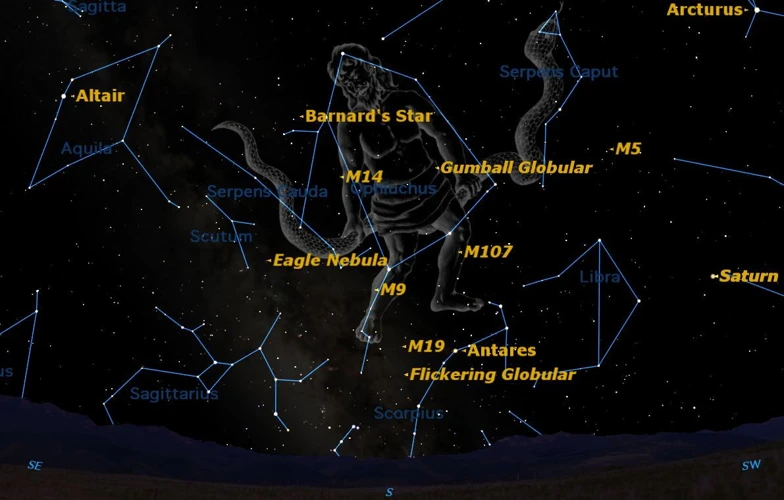
Embarking on a journey to discover the lesser-known constellations is like stepping into a hidden world of celestial wonders. While we may be familiar with the popular constellations that dominate the night sky, there is a whole host of captivating constellations that often go unnoticed. These hidden gems include Serpens, Ara, Scutum, Lupus, and Corona Australis. Each constellation has its own unique features and mythology that make them worth exploring. Serpens, for example, is divided into two parts, Serpens Caput and Serpens Cauda, representing the serpent’s head and tail, respectively. Ara, on the other hand, is known for its vibrant stars and its connection to the mythical altar. Scutum is home to the Scutum Star Cloud, a region of intense star formation, while Lupus is characterized by its distinct shape resembling a wolf. Lastly, Corona Australis, meaning “southern crown,” holds symbolic significance and is marked by its beautiful star clusters. By discovering and appreciating these lesser-known constellations, we can deepen our understanding of the vast cosmos and the stories they hold.
1. Serpens
Serpens, the serpent constellation, is one of the constellations that shares its boundaries with Ophiuchus. It is often depicted as a snake slithering between Ophiuchus and Hercules. Serpens is further divided into two distinct parts: Serpens Caput (the snake’s head) and Serpens Cauda (the snake’s tail). Serpens Caput is located to the east of Ophiuchus, and it is known for its bright star called Unukalhai, which means “the serpent’s neck” in Arabic. On the other hand, Serpens Cauda is situated to the west of Ophiuchus, and its notable feature is the Messier 16 star cluster, also known as the Eagle Nebula. This nebula is renowned for its pillar-like structures where new stars are believed to be forming. Serpens is an intriguing constellation to explore, with its unique representation of a serpent weaving its way through the night sky. Its connection to Ophiuchus and its captivating celestial features make it a delight for stargazers and astronomers alike.
2. Ara
Ara, also known as the Altar, is a lesser-known constellation located in the southern hemisphere. Represented as an altar used for sacrificial offerings in Greek mythology, Ara holds its own unique beauty and significance in the night sky. The constellation is bordered by the constellations Scorpius and Triangulum Australe, and it is home to several notable stars, including Beta Arae and Theta Arae. Beta Arae, also known as “Cervantes,” is a blue giant star that shines brightly in the constellation. Theta Arae, on the other hand, is a binary star system consisting of two stars orbiting each other. The name “Ara” is derived from the Greek word for altar, symbolizing the connection between the heavens and the earthly realm. In ancient cultures, the altar was considered a place of both worship and sacrifice, acting as a bridge between humans and the gods. The constellation Ara serves as a reminder of this ancient tradition and invites us to contemplate the mysteries of the universe. Whether you’re a seasoned stargazer or a curious beginner, taking the time to observe and appreciate the hidden wonders of Ara can truly be a rewarding experience. So, grab your telescope and embark on a journey to uncover the celestial secrets of this remarkable constellation.
3. Scutum
Scutum, the Latin word for “shield,” is a small constellation located in the southern sky. It was named by the Polish astronomer Johannes Hevelius in the 17th century, who depicted it as a shield held by King Sobieski of Poland. Despite its small size, Scutum holds a significant celestial gem known as the Scutum Star Cloud. Located within this cloud is a cluster of stars called Messier 11, or the Wild Duck Cluster. This cluster is known for its bright stars and its resemblance to a flock of ducks in flight. The Scutum Star Cloud and Messier 11 are popular targets for amateur astronomers due to their easily observable nature. Aside from its astronomical significance, Scutum holds historical value as well. During the early 1900s, the Harvard College Observatory conducted extensive research on variable stars within Scutum, contributing to our understanding of stellar evolution. So, if you’re an astronomy enthusiast or simply fascinated by celestial wonders, Scutum offers a fascinating glimpse into the mysteries of the night sky.
Click here to learn more about the different types and characteristics of meteors.
4. Lupus
Lupus, the Latin word for “wolf,” is a constellation that can be found in the southern sky. It is regarded as one of the lesser-known constellations, often overshadowed by its neighboring constellations such as Centaurus and Scorpius. Lupus is unique in its shape, resembling a wolf with its head pointing south and its body extending to the east. The constellation is home to several notable stars, including the brightest star in Lupus, Alpha Lupi, which shines with a beautiful blue-white glow. Other prominent stars within Lupus include Beta Lupi, Gamma Lupi, and Delta Lupi. Despite being lesser-known, Lupus has played a significant role in ancient cultures and mythologies. In ancient Greek mythology, Lupus was associated with the story of Hera’s cattle and the hero Hercules, who fought alongside Lupus to retrieve them. The constellation represents the wolf that Hercules encountered during his quest. In Aboriginal Australian culture, Lupus was seen as the footprint of the Emu in the Sky, an important symbol in their celestial stories. Exploring Lupus and its connections to mythology and ancient beliefs adds richness to our understanding of the night sky. So, next time you find yourself gazing at the stars, don’t forget to seek out the elusive Lupus constellation and appreciate its hidden wonders.
5. Corona Australis
Corona Australis, meaning “Southern Crown,” is a small constellation located in the southern hemisphere. As the name suggests, it represents a crown-like shape when observed in the night sky. This constellation is situated near the Sagittarius constellation and is best viewed during the winter months in the southern hemisphere. Corona Australis is home to numerous intriguing features. One of its notable attractions is the Corona Australis Nebula, a dark cloud of dust and gas where new stars are born. This nebula is a prime location for astronomers to study the process of stellar formation and evolution. Within the constellation, you can also find a few bright stars like Alphecca Meridiana and Delta Coronae Australis, which add to the overall allure of this lesser-known constellation. Legend has it that Corona Australis represents a crown given by Dionysus, the Greek god of wine, to Ariadne, the daughter of King Minos. This connection between mythology and the celestial world adds an extra layer of fascination to the Corona Australis constellation. So if you find yourself gazing at the southern skies, don’t forget to seek out the enchanting beauty of Corona Australis. It’s a true gem waiting to be discovered.
Exploring Serpens
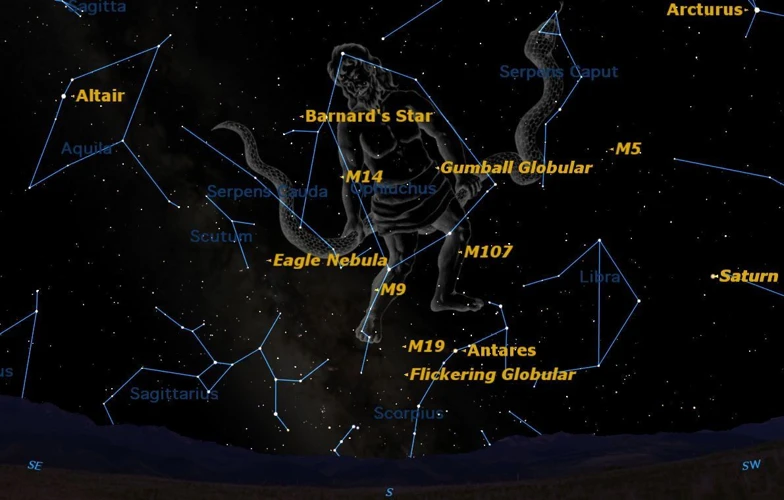
Exploring Serpens, a constellation adjacent to Ophiuchus, takes us on a voyage through the celestial serpent. This constellation is divided into two parts: Serpens Caput (the Serpent’s Head) and Serpens Cauda (the Serpent’s Tail). Serpens Caput is home to various intriguing celestial objects, including a globular cluster called Messier 5 and a star named Unukalhai, which means “the serpent’s neck” in Arabic. On the other hand, Serpens Cauda boasts the fascinating Eagle Nebula, which is known for its distinctive pillar-like structures where stars are born. Both parts of Serpens offer a plethora of celestial treasures to be discovered and admired. So, grab your telescope and embark on an expedition to witness the captivating wonders of Serpens! And for those interested in exploring the influence of Ophiuchus and its neighboring constellations on personal horoscopes and astrological readings, delve into the link for a deeper understanding.
The Serpens Caput
The Serpens Caput, also known as the Serpent’s Head, is a distinctive part of the Serpens constellation. It is located in the northern hemisphere of the celestial sphere and is one of the two main subdivisions of Serpens, the other being the Serpens Cauda or Serpent’s Tail. The Serpens Caput is characterized by its notable stars, including Unukalhai, which is the brightest star in this part of the constellation. Unukalhai, derived from the Arabic phrase meaning “the snake’s neck,” serves as the head of the celestial serpent.
In ancient mythology, the Serpens Caput is often associated with various stories and interpretations. In Babylonian astronomy, this region of the sky was linked to the serpent god Ningishzida, who was believed to protect the underworld and bring fertility and abundance to the land. The Greeks associated the Serpent’s Head with the story of Asclepius, the god of medicine and healing, who was depicted holding a serpent and symbolized by the constellation Ophiuchus. The Serpens Caput complements the Ophiuchus constellation, as they are intricately connected in the celestial sphere.
Whether viewed as a separate entity or in conjunction with Ophiuchus, the Serpens Caput offers stargazers and astronomers a fascinating exploration of the cosmos. Its prominent stars and rich mythological connections make it a captivating subject for celestial enthusiasts. As the serpent slithers across the night sky, it serves as a reminder of the wonders and mysteries that await our exploration in the vast expanse of the universe. For astrology enthusiasts, the Serpens Caput also holds significance in terms of its potential impact on personal horoscopes and astrological readings. Understanding its symbolic representation and relationship with other constellations can provide a deeper understanding of the influence of celestial bodies on our lives. However, it is important to note that interpretations of astrology can vary, and not all astrologers recognize or include the Serpens Caput in their readings.
The Serpens Cauda
The Serpens Cauda, also known as the “Tail of the Serpent,” is a prominent part of the larger Serpens constellation. Located adjacent to the Serpens Caput, the Serpens Cauda is easily identifiable in the night sky. One of its notable features is the star called Beta Serpentis, which shines brightly as the fourth-brightest star in the constellation. This star, also known as Chort, is a binary star system consisting of two stars orbiting around a common center of mass. The Serpens Cauda is often associated with the mythological figure of Ophiuchus, the Serpent Bearer. According to legend, Ophiuchus used his serpents to heal wounds and cure diseases, making this constellation a symbolic representation of healing and medicine. In astrology, the association of the Serpens Cauda with Ophiuchus has given rise to additional interpretations of personal horoscopes and astrological readings. However, it is essential to note that these interpretations are not widely accepted within the mainstream astrological community.
Unlocking the Secrets of Ara

Ara, the celestial Altar, is a lesser-known constellation that holds its own hidden wonders. Situated in the southern hemisphere, Ara is adorned with bright stars that form a unique shape resembling an ancient sacrificial altar. Among the notable stars in Ara is Beta Arae, a binary star system that captivates astronomers with its variability. In mythology, Ara is associated with the altar used by the gods during the war against the Titans. While Ara may not be as well-known as other constellations, its significance is undeniable. From the mythological connections to the vibrant stars it contains, Ara invites stargazers to unlock the secrets of this intriguing celestial formation. So, if you’re ready to expand your astronomical knowledge beyond the familiar, step into the realm of Ara and uncover the mysteries it holds. And for those curious about the impact Ophiuchus has on personal horoscopes and astrological readings, explore the link to dive even deeper into the celestial realm.
Ara and its Brightest Stars
Ara, also known as the Altar, is a constellation located in the southern hemisphere. It is named after the altar used in ancient Greek and Roman religious ceremonies. Within the Ara constellation, there are several notable stars that stand out. One of the brightest stars in Ara is Beta Arae, also known as “Husseini”, which is a binary star system composed of two stars orbiting each other. Another prominent star is Epsilon Arae, also called “Kakkab”, which is a blue-white giant star located approximately 320 light-years away from Earth. It is one of the most massive stars in the Ara constellation. Another intriguing star in Ara is Mu Arae, a star system that gained attention due to the discovery of multiple exoplanets orbiting it. Mu Arae hosts at least four known planets, making it a fascinating target for astronomers studying planetary systems. These brightest stars within the Ara constellation contribute to its overall beauty and captivate the eyes of stargazers and astronomers alike. If you’re interested in exploring the celestial connections between Ophiuchus and the broader constellations, you might also consider delving into the impact of Ophiuchus on personal horoscopes and astrological readings, offering alternative perspectives on the zodiac signs and their influence on our lives.
Ara’s Mythological Connection
Ara, the southern constellation of the Altar, has its own fascinating mythological connection that adds to its allure in the night sky. In Greek mythology, the constellation is associated with the altar where the gods made their sacred oaths. The story goes that when the gods waged war against the Titans, they sought assistance from the Cyclopes, who in turn demanded an altar built for them as a condition for their help. This altar, known as the Ara, was constructed, and the Cyclopes then forged lightning bolts for Zeus, Poseidon, and Hades. The Altar became a symbol of solidarity and unity among the gods. In another legend, Ara is tied to the sacrifice of the Centaur Chiron, who was known for his wisdom and healing abilities. Representing the ceremonial significance and divine acts, the mythology surrounding Ara deepens the cosmic narrative of the constellation. It serves as a reminder of the ancient cultural beliefs and the celestial connection to human life. Whether you’re an astronomy enthusiast or simply intrigued by the mythical tales of the stars, Ara’s mythological connection adds a layer of mystique to this lesser-known constellation. For those interested in exploring the astrological side, Ara may also play a role in personal horoscopes and astrological readings for individuals interested in a more nuanced perspective.
Unveiling the Wonders of Scutum
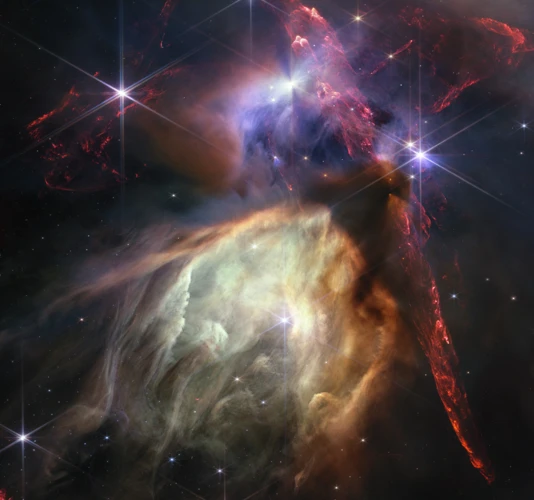
Scutum, also known as the Shield, is a small but noteworthy constellation nestled between the constellations Aquila and Sagittarius. Its name is derived from its shape, resembling a medieval shield. The most notable feature of Scutum is the Scutum Star Cloud, a dense region of stars located within its borders. This star cloud is home to several fascinating celestial objects, including open clusters and nebulae. One of the most prominent is the Eagle Nebula, also known as Messier 16, which is famous for its “Pillars of Creation.” These towering columns of gas and dust are a sight to behold. Scutum also holds historical significance as it was first introduced as a constellation in the 17th century by the Polish astronomer Johannes Hevelius. Its relatively modest size and unique shape make Scutum a captivating destination for stargazers and astronomers alike, offering a glimpse into the wonders of the universe. For those interested in exploring the celestial realm beyond the physical wonders of Scutum, horoscopes and astrological readings offer a different perspective on the impact Ophiuchus and other constellations can have on personal lives and personalities.
The Scutum Star Cloud
The Scutum Star Cloud is a fascinating feature within the Scutum constellation that is worth exploring. It is a dense region of stars located within the Milky Way galaxy, and it is often referred to as the Wild Duck Cluster. This name comes from the appearance of the stars, which resemble a flock of ducks flying in formation. The Scutum Star Cloud is home to hundreds of hot and young stars, making it a vibrant and active region of stellar formation. What makes this cluster even more intriguing is its proximity to the center of our galaxy. Its location provides astronomers with valuable insights into the formation and evolution of stars within the Milky Way. The Scutum Star Cloud is easily visible with a pair of binoculars or a small telescope, allowing amateur astronomers to appreciate its beauty. So, if you’re looking for a celestial wonder that combines stellar formation and the sheer brilliance of countless stars, the Scutum Star Cloud is the perfect destination to marvel at the mysteries of the universe.
The Historical Significance of Scutum
The constellation Scutum, also known as the Shield, holds a rich historical significance in the world of astronomy. It was first introduced by the Polish astronomer Johannes Hevelius in the late 17th century, during a time when new constellations were being added to fill gaps in the sky. The name Scutum refers to the Latin word for “shield,” as the constellation’s shape resembles a small shield. Scutum is located in the southern hemisphere and is situated between the constellations of Aquila and Sagittarius. While Scutum may not contain any particularly bright or notable stars, its historical significance lies in its connection to celestial cartography. Hevelius created Scutum to honor the Polish king, Jan III Sobieski, who successfully defended Europe against the Ottoman Empire in the famous Battle of Vienna. By including Scutum in his star maps, Hevelius showcased his loyalty and admiration for the king. Today, Scutum serves as a testament to the role of astronomy in commemorating significant historical events. Whether we observe Scutum as a shield or as a representation of bravery and victory, its historical significance adds another layer of fascination to the study of the night sky.
Untangling the Lupus Constellation

Nestled in the southern celestial hemisphere, the Lupus constellation is a fascinating astronomical formation that deserves our attention. Lupus, which means “wolf” in Latin, is associated with mythology and folklore across different cultures. The constellation is said to represent a wolf that was killed by the legendary Greek hero Heracles during his twelve labors. Lupus is home to various notable stars such as Men (Alpha Lupi) and the Wolf-Rayet star system Gamma^2 Velorum. These stars, along with others in Lupus, showcase the constellation’s intricate beauty and add to the allure of the night sky. While Lupus may not be as well-known as some other constellations, its significance in ancient cultures and its celestial marvels make it a worthy addition to any sky gazing adventure. So grab your telescope and marvel at the celestial wonders of Lupus, as it shines brightly alongside its neighboring constellations.
Identifying Lupus’ Major Stars
Identifying the major stars in the Lupus constellation is an exciting journey into the depths of the night sky. This constellation is situated in the southern hemisphere and is known for its distinct shape resembling a wolf. Within Lupus, there are several notable stars that stand out. One such star is Alpha Lupi, also known as Men, which is the brightest star in the constellation. It is a binary star system, composed of two stars orbiting around a common center of mass. Another prominent star in Lupus is Beta Lupi, also called Ke Kouan, which is a blue-white giant star located approximately 480 light-years away from Earth. Additionally, Eta Lupi, also known as Marbach, is a triple star system that consists of two blue-white main sequence stars and a red dwarf star. These major stars in the Lupus constellation contribute to its overall brightness and add to the allure of this celestial formation. Their unique characteristics offer astronomers and stargazers an opportunity to delve deeper into the intricacies of the night sky. While Lupus may not be as well-known as some other constellations, it is undoubtedly a gem worth exploring. Whether observing these stars through a telescope or contemplating their significance from afar, Lupus provides a captivating experience for those fascinated by the wonders of the universe. So, grab your star chart, head outside on a clear night, and let the Lupus constellation reveal its secrets to you.
Lupus in Ancient Cultures
Throughout ancient cultures, the Lupus constellation has held significant meaning and symbolism. In ancient Greek mythology, it was believed that the constellation Lupus represented a wild animal, often associated with wolves or a wolf-like creature. The Romans also associated Lupus with a wolf, and it was considered one of the first 48 constellations documented by the astronomer Ptolemy in the 2nd century. In Native American astronomy, the Lupus constellation was associated with the winter season and was seen as a reflection of the power and strength of the wolf. Indigenous tribes saw the constellation as a protector and guide during the cold winter months. The rich history and cultural significance of Lupus in ancient civilizations highlight the enduring fascination and connection between humans and the stars. While Lupus may not be as well-known as other constellations, its presence in ancient cultures adds to the tapestry of celestial mythology and folklore. To continue the exploration of constellations and their impact, you can also delve into the world of personal horoscopes and astrological readings, gaining insight into the potential influence of constellations like Ophiuchus in shaping individual traits and destinies.
Journeying through Corona Australis

Embark on a celestial journey through the captivating constellation of Corona Australis, the Southern Crown. This constellation, located in the southern hemisphere, is often overlooked but holds its own wonders to behold. Named after the Latin word for “crown,” Corona Australis is home to several notable features, including the beautiful R Coronae Australis, a young stellar system surrounded by glowing gas and dust. Another remarkable feature is the Corona Australis Nebula, a region of star formation and stellar nurseries. With its intriguing celestial objects and its symbolic representation as a crown, exploring Corona Australis offers a unique opportunity to witness the beauty and dynamism of the universe. So pack your curiosity and prepare to be dazzled by this lesser-known gem in the night sky.
Corona Australis’ Notable Features
Corona Australis, also known as the Southern Crown, is a constellation located in the southern sky. Let’s delve into some of the notable features that make this constellation truly intriguing:
1. Crown-like Shape: The name “Corona Australis” translates to “southern crown” in Latin, and true to its name, this constellation appears like a shimmering crown adorning the night sky. Its distinctive shape makes it easily recognizable.
2. Bright Stars: Within Corona Australis, there are several bright stars that deserve attention. One of the most prominent stars is Alfecca Meridiana, also known as Alpha Coronae Australis, which shines with a luminosity greater than the Sun. Other notable stars include Beta Coronae Australis and Theta Coronae Australis, each contributing their own unique brilliance to the constellation.
3. The Coronet Cluster: Corona Australis is home to a stunning cluster of stars known as the Coronet Cluster, or NGC 6541. This cluster, located at the western end of the constellation, is a tight grouping of stars that forms a mesmerizing spectacle when observed through a telescope. Its dazzling nature makes it a favorite target for stargazers and astronomers alike.
4. Nebulae and Dark Clouds: In addition to its stars, Corona Australis also has fascinating nebulae and dark clouds that add to its allure. One such feature is the R Coronae Australis nebula, which is associated with young stellar objects and is a site of active star formation. The presence of these nebulae and dark clouds creates a captivating backdrop against the shining stars of the constellation.
As you can see, Corona Australis is not only visually stunning but also holds many celestial wonders within its boundaries. Whether you’re an avid stargazer or simply appreciative of the beauty of the night sky, this constellation is definitely worth exploring. So, grab your telescope and prepare to witness the magnificent features of Corona Australis up close.
The Symbolism of Corona Australis
Corona Australis, meaning “Southern Crown” in Latin, is a small constellation located in the southern hemisphere. It is often overlooked due to its size and proximity to other more prominent constellations. However, despite its modest appearance, Corona Australis holds significant symbolism in ancient cultures. In Greek mythology, this constellation is associated with the crown worn by the god Dionysus. The crown represents his triumph and attainment of divinity. According to the Greeks, Dionysus was the god of wine and celebration, representing the joy and abundance of life. The crown of Corona Australis signifies the heavenly reward and recognition bestowed upon Dionysus for his contributions. Corona Australis has connections to the solar eclipse, with its distinctive shape resembling a radiant crown. This reinforces the idea of celestial power and cosmic alignment. The symbolism of Corona Australis reminds us of the human desire for achievement, celebration, and the pursuit of greatness. It serves as a reminder to embrace life’s pleasures and find joy in our accomplishments. As with any constellation, it is important to remember that cultural interpretations may vary, and for those interested in astrology and horoscopes, exploring the impact of Ophiuchus on personal readings offers an alternative perspective on celestial symbolism and significance.
Celestial Connections
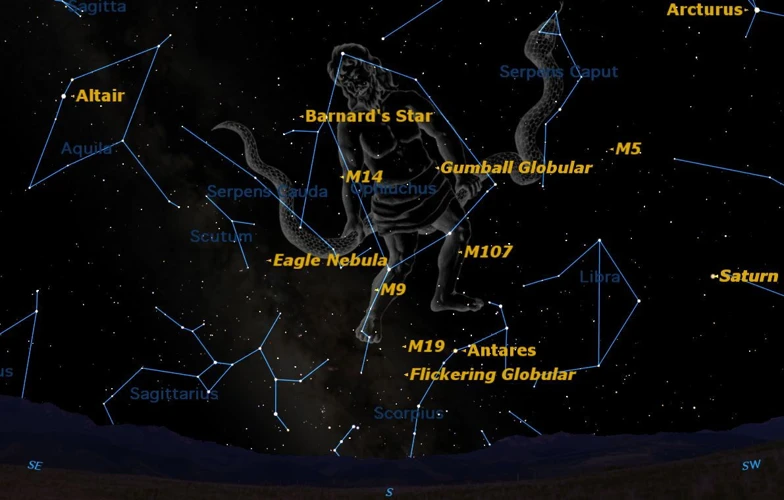
The night sky is a vast and interconnected tapestry of celestial bodies, each with its own unique story and significance. When it comes to the constellation of Ophiuchus, its celestial connections add to its mystique and intrigue. Ophiuchus interacts with the lesser-known constellations in fascinating ways, forming celestial relationships that captivate stargazers. Whether it’s the close proximity of Ophiuchus to the Scorpius and Sagittarius constellations, or its alignment with the serpent-like Serpens constellation, these celestial connections bring a sense of harmony and interconnectedness to the night sky. Exploring these connections can deepen our understanding of the celestial realm and provide insight into how different constellations coexist and interact with one another. It’s like peering into a vast cosmic dance, with each constellation playing its part in the grand celestial choreography. So, take a moment to appreciate the celestial connections surrounding Ophiuchus and marvel at the beauty and complexity of our universe.
Interactions Between Ophiuchus and the Lesser-Known Constellations
The interactions between Ophiuchus and the lesser-known constellations create a celestial tapestry that is truly mesmerizing. Ophiuchus forms a physical connection with neighboring constellations, enhancing the beauty and significance of both. One such interaction can be observed between Ophiuchus and the constellation Serpens. Given its association with snakes, it is no surprise that Ophiuchus intertwines with Serpens, which is symbolized as a serpentine creature. This connection highlights the intertwining relationship between healing and transformation, as represented by Ophiuchus’ association with medicine and Serpens’ depiction as a snake. Another fascinating interaction takes place between Ophiuchus and the constellation Ara. Ara, known as the Altar, portrays a sacrificial altar which holds deep symbolic significance. In this interplay, Ophiuchus appears to be guarding or protecting the altar, creating a dynamic visual narrative that speaks to the perpetuation of healing and protection. The constellation Scutum interacts harmoniously with Ophiuchus. Scutum, often referred to as the Shield, complements Ophiuchus’ role as a protector and healer, reinforcing the importance of strength and defense in the pursuit of well-being. As we venture further, we encounter Lupus, the Wolf, in close proximity to Ophiuchus. Lupus embodies the wild and primal aspects of nature, allowing us to reflect on the untamed forces that balance the healing energies represented by Ophiuchus. Lastly, Ophiuchus interacts with Corona Australis, the Southern Crown. This connection alludes to the celestial unity, as the crown seems to be bestowed upon the Serpent Bearer, symbolizing the recognition of Ophiuchus’ healing wisdom and noble endeavors. Together, these interactions paint a vivid picture of the interconnectedness and intricate relationships between Ophiuchus and the lesser-known constellations, inviting us to explore and appreciate the vastness of the cosmos. For those intrigued by the impact of Ophiuchus on personal horoscopes and astrological readings, there are alternative perspectives and interpretations available that delve into the influence of this unique constellation on individual signs and birth charts.
Conclusion

In conclusion, the exploration of the lesser-known constellations alongside Ophiuchus opens up a world of wonder and discovery in the night sky. We have unraveled the mythology behind Ophiuchus, a constellation portraying the renowned healer Asclepius. We have also delved into the stars and features of Ophiuchus, showcasing its unique position between Scorpius and Sagittarius. However, the true magic lies in the discovery of the lesser-known constellations that often go unnoticed. From the serpent-like Serpens to the mighty Ara, the majestic Scutum, the mysterious Lupus, and the enchanting Corona Australis, each of these constellations has its own stories, stars, and symbolism waiting to be explored.
By journeying through these constellations, we not only deepen our understanding of the cosmos but also gain insights into the historical, mythological, and cultural significance they hold. The secrets of Serpens Caput and Serpens Cauda reveal the dual nature of healing and transformation. Ara, with its brightest stars, beckons us to connect with the mythological tale of the celestial altar. Scutum, known for its star cloud, invites us to witness its historical role in cartography. Lupus, as its name suggests, represents the wolf and carries various interpretations across ancient cultures.
Lastly, Corona Australis unravels its notable features, reminding us of the symbolism it holds in shaping our perception of royalty and celestial beauty. The interactions between Ophiuchus and these lesser-known constellations create celestial connections that enhance our appreciation for the vastness and interconnectedness of the universe. While astrology enthusiasts may find interest in exploring the impact of Ophiuchus on personal horoscopes and astrological readings, it is crucial to approach such interpretations with discernment, as they may diverge from mainstream astrology.
In the end, the journey to uncover the lesser-known constellations alongside Ophiuchus serves as a reminder that there is always more to discover and explore in the night sky. Whether you are an avid astronomer, a mythology enthusiast, or simply a curious stargazer, the wonders of these constellations await your exploration. So next time you gaze up at the stars, remember to seek out the hidden stories and celestial marvels that lie beyond the familiar constellations we often encounter. Keep looking up, and may your cosmic adventures continue to inspire and ignite a sense of wonder within you.
Frequently Asked Questions

1. What is the significance of the Ophiuchus constellation?
The Ophiuchus constellation holds cultural and mythological significance. It represents Asclepius, the Greek god of medicine and healing, and is associated with themes of wisdom, knowledge, and the power of healing.
2. How can I locate the Ophiuchus constellation in the night sky?
To locate the Ophiuchus constellation, look for it between the constellations Scorpius and Sagittarius. It is situated near the celestial equator and can be seen in the northern hemisphere during the summer months.
3. What are some notable stars in the Ophiuchus constellation?
The Ophiuchus constellation is home to several bright stars, including Rasalhague and Sabik. Rasalhague, the brightest star in Ophiuchus, is a binary star system located approximately 49 light-years away from Earth.
4. Are there any myths or legends associated with Ophiuchus?
Yes, in Greek mythology, Ophiuchus represents Asclepius, the healer. According to the myth, Asclepius possessed the power to revive the dead, which led to his placement among the stars as a constellation. This legend highlights the connection between the sky and the art of healing.
5. Are there any famous celestial objects located within the Ophiuchus constellation?
While the Ophiuchus constellation itself does not contain any famous celestial objects, it serves as a guide to many interesting deep-sky objects nearby. Some examples include the Eagle Nebula, the Lagoon Nebula, and the globular cluster Messier 10.
6. How does Ophiuchus relate to astrology?
In astrology, Ophiuchus has gained attention as a potential thirteenth zodiac sign, challenging the traditional zodiac system. However, it’s important to note that this interpretation is not widely recognized in mainstream astrology.
7. Can I see the Ophiuchus constellation with the naked eye?
Yes, the Ophiuchus constellation is visible to the naked eye, especially in areas with minimal light pollution. It is best observed during the summer months in the northern hemisphere.
8. What astronomical phenomena have been observed near Ophiuchus?
Several astronomical phenomena have been observed near the Ophiuchus constellation. For example, the famous Eagle Nebula, also known as the “Pillars of Creation,” is located in the same region of the sky.
9. Are there any notable historical references to the Ophiuchus constellation?
While the Ophiuchus constellation lacks significant historical references, its presence in ancient sky maps and mythologies showcases its importance in different cultures and their understanding of the cosmos.
10. How can I learn more about other constellations alongside Ophiuchus?
To learn more about the other constellations that accompany Ophiuchus, explore astronomy books, online resources, or consider visiting a local planetarium or observatory. These sources can provide detailed information and offer opportunities for stargazing and celestial observations.
References
- Is Ophiuchus the 13th constellation of the zodiac?
- Astronomy not astrology: Ophiuchus – The Anchor Newspaper
- Spotted! A Rarely Seen Constellation Shines This Summer
Frequently Asked Questions

1. What is the significance of Ophiuchus in astrology?
Ophiuchus is often referred to as the “Serpent Bearer” and is associated with healing and wisdom. In astrology, it represents a blend of various traits such as intuition, a desire for knowledge, and the ability to transform difficult situations.
2. How does Ophiuchus differ from other constellations?
Ophiuchus stands out due to its unique positioning between Scorpius and Sagittarius. It is one of the larger constellations in the night sky and is known for its distinctive shape resembling a man struggling with a serpent.
3. Are the lesser-known constellations overlooked in astronomy?
While some of the lesser-known constellations may not be as widely recognized, they still hold astronomical importance. These constellations provide additional points of interest for stargazers and contribute to the rich tapestry of our night sky.
4. What are some interesting facts about the Serpens constellation?
The Serpens constellation is divided into two parts: Serpens Caput (the Serpent’s Head) and Serpens Cauda (the Serpent’s Tail). It is notable for containing the famous star cluster Messier 5, which is one of the oldest known globular clusters.
5. What is the mythological connection behind the Ara constellation?
In Greek mythology, Ara is associated with the altar on which Zeus and the other gods made their solemn oaths. The constellation represents the altar and is symbolized by a man holding a burning offering.
6. How does the Scutum constellation hold historical significance?
The Scutum constellation was introduced by Polish astronomer Johannes Hevelius in the 17th century. It was created to commemorate the Treaty of Oliwa, which ended the Polish-Swedish war. This constellation honors the peace settlement reached between the two nations.
7. What is the cultural significance of the Lupus constellation?
In ancient cultures, Lupus was often associated with a wolf. It was believed that the constellation represented the wolf that nursed and saved the twin brothers Romulus and Remus, who went on to found Rome.
8. What are the notable features of Corona Australis?
Corona Australis includes a dark nebula known as the “Coalsack Nebula” and a globular star cluster called NGC 6723. These features make the constellation visually striking and offer exciting opportunities for exploration and observation.
9. How do the constellations interact with each other?
Ophiuchus interacts with the lesser-known constellations through their proximity in the night sky. The constellations may share neighboring stars, form patterns together, and provide references for stargazers to locate one another in the celestial sphere.
10. Why are the lesser-known constellations worth exploring?
The lesser-known constellations offer a chance to discover new celestial wonders. Exploring these constellations allows for a deeper understanding of our vast universe and uncovers hidden stories and connections that enrich our knowledge of the night sky.

